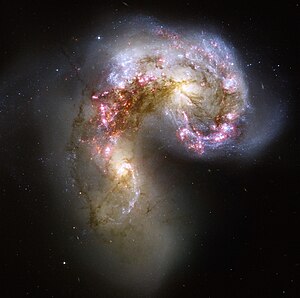Starburst galaxy


A starburst galaxy is a galaxy with a very high rate of star formation. The rate of star formation is so large that the galaxy will quickly use all of its gas reservoir (from which the stars are made).
So, the starburst nature of a galaxy is a short phase in a galaxy's evolution, just tens of millions of years. Most starburst galaxies are in the midst of a galaxy merger or at least close encounter with another galaxy.
Studying nearby starburst galaxies can help us explore the history of galaxy formation and evolution. Many very distant galaxies seen, for example, in the Hubble Deep Field are known to be starbursts, but they are too far away to be studied in any detail. Looking at nearby examples give us an idea of what was happening in the early universe. The light we see from distant galaxies left them when the universe was much younger (see redshift).
Starburst galaxies seem to be quite rare in our local universe, and are more common further away. This suggests there were more of them billions of years ago. All galaxies were closer together then, and therefore more likely to be influenced by each other's gravity. More frequent encounters produced more starbursts as galactic forms evolved with the expanding universe.
Notable and well-known starburst galaxies[change | change source]
These include:
- M82- The prototype of this class of galaxy and is interacting with Messier 81.Also know as the Cigar Galaxy.
- Antennae galaxies (NGC 4038/NGC 4039) This is actually 2 galaxies, interacting and merging.
- IC 10- The only starburst galaxy in the Local Group and just a mild one.
- Centaurus A- The only case of an elliptical starburst galaxy.
- Messier 100- A so-called Grand design spiral galaxy in Virgo.
- Cartwheel galaxy- A famous ring galaxy.
